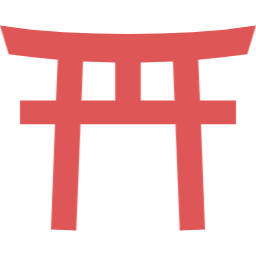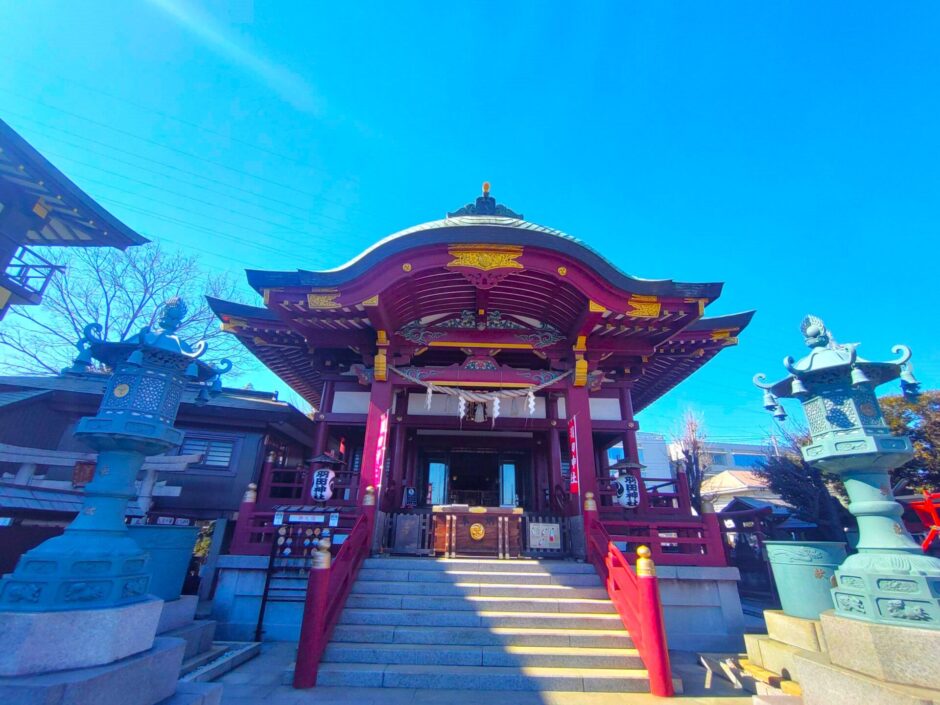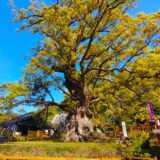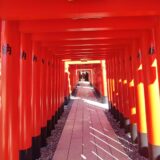目次
- 【Haneda Shrine summary】
- 【Haneda Shrine road approaching a shrine】
- 【Haneda Shrine purification fountain】
- 【Haneda Shrine main shrine】
- 【Haneda Shrine mound covering reverently buried old fujis】
- 【Haneda Shrine subordinate shrine】
- 【Haneda Shrine Adjacent Jiseiin Temple】
- 【Haneda Shrine GOSHUIN】
- 【Haneda Shrine Nearby attractions】
- 【Haneda Shrine Access】
- Manager’s Comments
- Haneda Shrine
【Haneda Shrine summary】
Haneda Shrine is said to have been built in 1258 during the Kamakura period (1185-1333). It is said to have been built in 1258 during the Kamakura period (1185-1333), when the naval lords of Hanedaura enshrined Gozutenno, the god of war. In 1861, when the smallpox epidemic broke out, the shogun Iesada Tokugawa visited the shrine to pray for the cure of the disease. However, the name “Gozutenno” was banned with the separation of Shinto and Buddhist during the Meiji period (1868-1912), and the shrine was renamed Haneda Shrine in 1907, changing the deity to Susano-o-mikoto, who had been in union with Ushitotenno. The shrine was formerly known as Yakumo Shrine and Gozutenno-sha.
Due to the separation of Shintoism and Buddhism, the current deities are Susano-no-mikoto and Inadahime-no-mikoto, a married couple.
【Haneda Shrine road approaching a shrine】
![Haneda Shrine, Jiseiin Temple [Tokyo] DSC 1865 1024x768 - Haneda Shrine, Jiseiin Temple [Tokyo]](https://japan-shrine.info/wp-content/uploads/DSC_1865-1024x768.jpg)
There is a large road in front of the approach to the shrine, and the traffic is heavy. However, once on the approach to the shrine, I was impressed by the magnificent main shrine and torii gate in a quiet and serene atmosphere.
【Haneda Shrine purification fountain】
![Haneda Shrine, Jiseiin Temple [Tokyo] DSC 1866 2 1024x768 - Haneda Shrine, Jiseiin Temple [Tokyo]](https://japan-shrine.info/wp-content/uploads/DSC_1866-2-1024x768.jpg)
I thought it was unusual that it was a cow instead of a dragon, the guardian god of water. I mistakenly thought that Sugawara no Michizane was the god of worship, but the cow is treated differently. Is this a legacy of Gozutenno?
【Haneda Shrine main shrine】
![Haneda Shrine, Jiseiin Temple [Tokyo] DSC 1867 1024x768 - Haneda Shrine, Jiseiin Temple [Tokyo]](https://japan-shrine.info/wp-content/uploads/DSC_1867-1024x768.jpg)
The main shrine, completed in May 1988, is beautifully carved and has a stately appearance.
【Haneda Shrine mound covering reverently buried old fujis】
![Haneda Shrine, Jiseiin Temple [Tokyo] DSC 1870 1024x768 - Haneda Shrine, Jiseiin Temple [Tokyo]](https://japan-shrine.info/wp-content/uploads/DSC_1870-1024x768.jpg)
The thing at Haneda Shrine is called “Haneda Fuji” and was built in the early Meiji era. It is now designated as a tangible folk cultural property of Ota Ward, Tokyo. It was smaller than those of other shrines and easier to climb.
In Tokyo, Hatomori Hachiman Shrine, Shinagawa Shrine, and Gokokuji Temple also have them.
【Haneda Shrine subordinate shrine】
![Haneda Shrine, Jiseiin Temple [Tokyo] DSC 1874 1024x768 - Haneda Shrine, Jiseiin Temple [Tokyo]](https://japan-shrine.info/wp-content/uploads/DSC_1874-1024x768.jpg)
In addition to the main shrine, a number of subordinate shrines were enshrined. Three of them were Inari shrines. Because of the nature of the land in this area, Inari, the god of rice, was enshrined in the Edo period when new rice fields were developed, and was later forcibly removed and enshrined together for the expansion of the Tokyo Air Base.
【Haneda Shrine Adjacent Jiseiin Temple】
There is a temple next to Haneda Shrine. I can imagine that this is due to the separation of Shinto and Buddhism, so I visited this temple as well.
![Haneda Shrine, Jiseiin Temple [Tokyo] DSC 1880 1024x768 - Haneda Shrine, Jiseiin Temple [Tokyo]](https://japan-shrine.info/wp-content/uploads/DSC_1880-1024x768.jpg)
In the past, the shrine Ushitotenno-sha was enshrined in the precincts of the temple.
![Haneda Shrine, Jiseiin Temple [Tokyo] DSC 1882 1024x768 - Haneda Shrine, Jiseiin Temple [Tokyo]](https://japan-shrine.info/wp-content/uploads/DSC_1882-1024x768.jpg)
There is a “Gyuto Tenno Hall” in the precincts of the shrine, but this is not a remnant of Haneda Shrine, but was moved from Miwa Itsukushima Shrine in 1929.
![Haneda Shrine, Jiseiin Temple [Tokyo] DSC 1883 2 1024x768 - Haneda Shrine, Jiseiin Temple [Tokyo]](https://japan-shrine.info/wp-content/uploads/DSC_1883-2-1024x768.jpg)
Plum blossoms were in bloom in front of Ushitenno-do. A bush warbler was sucking honey. It will soon be spring.
【Haneda Shrine GOSHUIN】
![Haneda Shrine, Jiseiin Temple [Tokyo] DSC 1877 1024x742 - Haneda Shrine, Jiseiin Temple [Tokyo]](https://japan-shrine.info/wp-content/uploads/DSC_1877-1024x742.jpg)
GOSHUIN was stamped with red seals of airplanes, and an airplane-shaped bookmark was available as a souvenir. a red seal book in collaboration with JAL and ANA was also available.
![Haneda Shrine, Jiseiin Temple [Tokyo] 2025 02 14 19 02 Office Lens 762x1024 - Haneda Shrine, Jiseiin Temple [Tokyo]](https://japan-shrine.info/wp-content/uploads/2025_02_14-19_02-Office-Lens-762x1024.jpg)
【Haneda Shrine Nearby attractions】
Kamata Hachiman Shrine,Anamori Inari Shrine, Haneda Airport, Kawasaki Daishi
【Haneda Shrine Access】
Manager’s Comments
It is famous for praying for the safety of airplanes, but when I examine the history of the shrine, I find that the benefits are considered to be an afterthought. However, since it is a guardian deity of the Haneda area, it is revered by those involved in the aviation industry, which is why it has taken the form it has today.
Tennozu Isle” is not that close but is named after ‘Tenno’. I always visit shrines without prior knowledge, but when I put my hands together at this shrine, I was praying for my family’s good health, so many things became clear to me.
3-9-12, Honhaneda, Ota-ku, Tokyo 144-0044, Japan
※Free parking available.
 Tour of Japanese shrines and temples
Tour of Japanese shrines and temples 

![Haneda Shrine, Jiseiin Temple [Tokyo] DSC 1218 520x300 - Haneda Shrine, Jiseiin Temple [Tokyo]](https://japan-shrine.info/wp-content/uploads/DSC_1218-520x300.jpg)
![Haneda Shrine, Jiseiin Temple [Tokyo] DSC 1773 520x300 - Haneda Shrine, Jiseiin Temple [Tokyo]](https://japan-shrine.info/wp-content/uploads/DSC_1773-520x300.jpg)
![Haneda Shrine, Jiseiin Temple [Tokyo] DSC 0630 520x300 - Haneda Shrine, Jiseiin Temple [Tokyo]](https://japan-shrine.info/wp-content/uploads/DSC_0630-520x300.jpg)
![Haneda Shrine, Jiseiin Temple [Tokyo] DSC 1892 2 520x300 - Haneda Shrine, Jiseiin Temple [Tokyo]](https://japan-shrine.info/wp-content/uploads/DSC_1892-2-520x300.jpg)
![Haneda Shrine, Jiseiin Temple [Tokyo] DSC 1803 520x300 - Haneda Shrine, Jiseiin Temple [Tokyo]](https://japan-shrine.info/wp-content/uploads/DSC_1803-520x300.jpg)
![Haneda Shrine, Jiseiin Temple [Tokyo] DSC 1803 150x150 - Haneda Shrine, Jiseiin Temple [Tokyo]](https://japan-shrine.info/wp-content/uploads/DSC_1803-150x150.jpg)
![Haneda Shrine, Jiseiin Temple [Tokyo] DSC 1773 150x150 - Haneda Shrine, Jiseiin Temple [Tokyo]](https://japan-shrine.info/wp-content/uploads/DSC_1773-150x150.jpg)
![Haneda Shrine, Jiseiin Temple [Tokyo] DSC 1374 150x150 - Haneda Shrine, Jiseiin Temple [Tokyo]](https://japan-shrine.info/wp-content/uploads/DSC_1374-150x150.jpg)
![Haneda Shrine, Jiseiin Temple [Tokyo] DSC 0630 150x150 - Haneda Shrine, Jiseiin Temple [Tokyo]](https://japan-shrine.info/wp-content/uploads/DSC_0630-150x150.jpg)

